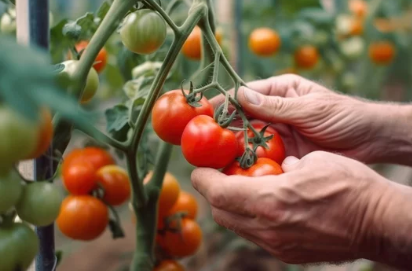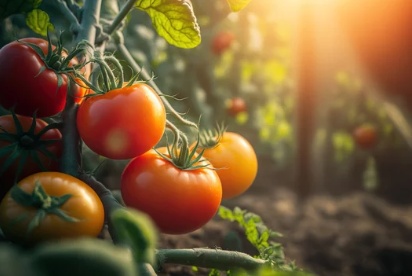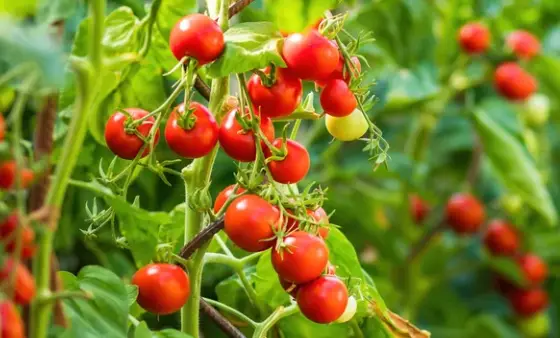Where Do Tomatoes Grow Naturally?
Tomatoes have become an indispensable part of cuisines around the world, adding vibrant colors, flavors, and nutrients to countless dishes.
However, have you ever wondered where these delicious fruits originated and where they grow naturally?
In this blog post, we will embark on a journey to uncover the historical origins and native habitats of tomatoes, shedding light on the diverse regions where they flourish.
Historical Origins of Tomatoes

To understand the roots of tomatoes, we must travel back in time to ancient Mesoamerica, which encompasses present-day Mexico and Central America.
The indigenous peoples of this region were the first to cultivate tomatoes, recognizing their culinary and medicinal value.
Tomatoes were an integral part of their diet, and their cultivation techniques were passed down through generations.
The introduction of tomatoes to Europe occurred during the era of Spanish colonization.
Spanish explorers encountered tomatoes during their expeditions to the Americas, bringing them back to Europe in the 16th century.
Initially, tomatoes faced skepticism due to their resemblance to deadly nightshade plants.
However, their vibrant colors and tantalizing taste eventually won over Europeans, leading to their widespread cultivation.
Native Habitat of Wild Tomatoes

In their natural state, wild tomatoes thrive in diverse climates and terrains.
Their native habitats include tropical rainforests, semi-arid regions, and high-altitude areas. Let’s explore a few notable wild tomato species and their respective native regions.
One prominent wild tomato species is Solanum pimpinellifolium, commonly known as the “currant tomato.”
This species can be found growing naturally in the coastal regions of Peru. It adapts well to sandy soils and humid climates, thriving in the heat of the tropical rainforests.
Another wild tomato species, Solanum lycopersicum cerasiforme, hails from Ecuador.
It is characterized by its small cherry-like fruits and grows in the Andean region, where the cool mountainous climate provides suitable conditions for its growth.
These wild tomato species serve as a reminder of the genetic diversity and adaptability of tomatoes.
Their native habitats offer invaluable resources for the development of new tomato cultivars with enhanced traits, such as disease resistance and flavor profiles.
Tomato Cultivation Around the World

Tomatoes have successfully been cultivated in various parts of the world, thanks to their ability to adapt to different climates and growing conditions.
From temperate regions to subtropical and Mediterranean climates, tomatoes have found their place in the agricultural landscapes of numerous countries.
Where Do Tomatoes Grow Naturally?
United States:
California and Florida are renowned for their extensive tomato production.
California’s favorable climate, with warm summers and mild winters, provides optimal conditions for tomato cultivation.
Florida, on the other hand, benefits from its subtropical climate and sandy soils, supporting year-round tomato production.
Italy:
Known for its rich culinary heritage, Italy is famous for its tomato-based dishes and sauces.
Regions like Campania, Sicily, and Puglia are celebrated for producing flavorful and vibrant tomatoes. The Mediterranean climate, with its long, hot summers, contributes to the exceptional quality of Italian tomatoes.
Spain:
Spain has a long history of tomato cultivation, with regions such as Almeria, Murcia, and Valencia leading the way.
The warm Mediterranean climate and fertile soils create a favorable environment for tomato growth.
Spain is also known for its greenhouse tomato production, allowing year-round cultivation.
China:
China is the largest producer of tomatoes globally, with regions like Xinjiang, Shandong, and Hebei contributing significantly to the country’s output.
The diverse climate zones in China support a wide range of tomato varieties, and advanced cultivation techniques have further boosted production.
India:
Tomato cultivation in India is widespread, with states like Maharashtra, Karnataka, and Andhra Pradesh being major producers.
The country’s diverse agro-climatic conditions allow for year-round cultivation, making tomatoes an essential crop for farmers.
Factors Affecting Tomato Growth
Several environmental factors play a crucial role in the growth and development of tomatoes.
Understanding these factors helps farmers optimize their cultivation practices and achieve better yields. Let’s explore some key elements that influence tomato growth:
Temperature:
Tomatoes thrive in temperatures between 70°F and 85°F (21°C to 29°C). Cooler temperatures can slow down growth, while excessive heat can affect fruit set and quality.
Sunlight:
Tomatoes require full sun exposure for at least 6 to 8 hours a day. Ample sunlight ensures optimal photosynthesis and fruit development.
Soil Composition:
Well-drained, fertile soils rich in organic matter are ideal for tomato cultivation. Soil pH between 6.0 and 7.0 is considered optimal for nutrient availability.
Moisture Levels:
Tomatoes require consistent soil moisture, but overwatering can lead to diseases such as root rot. Adequate irrigation and drainage are crucial for maintaining optimal moisture levels.
Tomato plants have evolved over time to adapt to diverse environments and climatic conditions, allowing their cultivation across the globe.
Modern Tomato Cultivation Techniques
Advancements in agricultural practices and technology have revolutionized tomato cultivation, enabling farmers to overcome challenges and increase production. Here are some modern tomato cultivation techniques:
Greenhouse Farming:
Greenhouses provide controlled environments, protecting tomato plants from adverse weather conditions and pests. This technique extends the growing season, ensuring a more consistent tomato supply.
Hydroponics:
Hydroponic systems allow tomato cultivation without soil, with plants receiving essential nutrients through a water-based solution. Hydroponics conserves water and space while enhancing nutrient uptake and crop productivity.
Vertical Farming:
In urban areas or limited land spaces, vertical farming utilizes stacked layers to grow tomatoes vertically. This method maximizes space utilization and increases overall crop yield.
These techniques have transformed the tomato industry, making it possible to cultivate tomatoes in regions previously unsuitable for traditional farming.
Conclusion
Tomatoes have come a long way since their humble beginnings in ancient Mesoamerica.
From their wild origins in diverse habitats to their global cultivation and adaptation, tomatoes have become a staple in cuisines worldwide.
With the historical origins and native habitats of tomatoes, we gain a deeper understanding of their significance and the cultural impact they have had throughout history.
So, the next time you enjoy a juicy tomato, take a moment to savor not only its taste but also its remarkable journey from the wild to your plate. I hope this information helped you.




